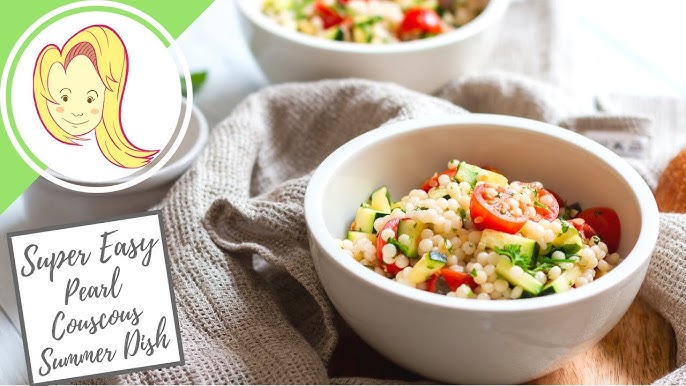Pearl Couscous Recipe: Pearl couscous, often referred to as Israeli couscous, is a type of toasted pasta shaped like small pearls. Unlike traditional couscous, which is made from semolina and has a finer texture, pearl couscous is larger, slightly chewy, and holds sauces and flavors beautifully. It’s an incredibly versatile ingredient that works in salads, soups, and main dishes. While it’s sometimes mistaken for a grain, it’s actually a form of pasta—just shaped differently. Originating in the Middle East, pearl couscous has become a popular choice in kitchens around the world thanks to its unique texture and ability to absorb flavors.
Think of it as the perfect middle ground between pasta and rice—offering that chewy satisfaction while being quicker to cook than many whole grains. You’ll often find it labeled as “Israeli couscous,” and it’s typically sold in the pasta section of grocery stores.
Nutritional Benefits of Pearl Couscous
Pearl couscous isn’t just tasty—it’s also a nutritious addition to your meals. A typical serving provides a decent amount of carbohydrates for energy, along with a bit of protein and fiber. It’s also low in fat and contains some essential minerals like selenium and iron. While it’s not gluten-free (since it’s made from wheat), it’s still a healthy option when balanced with vegetables, lean proteins, and healthy fats.
Adding ingredients like chickpeas, grilled chicken, or roasted veggies can make it a complete, balanced meal. Plus, its low sodium content makes it a heart-friendly choice—especially when you cook it with homemade broth or water instead of store-bought stock.
Ingredients You’ll Need
Main Ingredients
Here’s what you’ll need to make a simple yet delicious pearl couscous dish:
- 1 cup pearl couscous
- 1 tablespoon olive oil
- 1¾ cups water or vegetable broth
- ½ teaspoon salt (adjust to taste)
- Freshly ground black pepper (to taste)
This is your base. From here, you can add any flavors or mix-ins you like. The olive oil not only prevents sticking but also enhances the nutty flavor during the toasting step.
Optional Add-Ins for Extra Flavor
To elevate your couscous game, consider mixing in any of these tasty ingredients:
- Chopped fresh herbs (parsley, mint, cilantro)
- Crumbled feta or goat cheese
- Diced cucumbers, cherry tomatoes, and red onions
- Lemon zest and juice for a zesty finish
- Cooked chickpeas or black beans
- Roasted vegetables (zucchini, bell peppers, eggplant)
You can completely transform this simple side into a main course or a vibrant salad with these flavorful additions. It’s a fantastic way to use up leftover veggies or whatever herbs you have in the fridge.
Step-by-Step Cooking Instructions
Step 1: Toasting the Couscous
Start by heating the olive oil in a medium-sized saucepan over medium heat. Once the oil is warm, pour in your cup of pearl couscous. Stir it frequently for about 3 to 5 minutes, allowing the couscous to toast lightly until it turns golden brown. This step enhances the flavor, giving it a delicious nutty aroma—kind of like when you toast rice before making pilaf.
Toasting is key if you want depth of flavor. It’s not absolutely necessary, but it truly makes a difference in the final dish. Think of it like searing meat before stewing—it adds richness and complexity that plain boiling just can’t deliver.
Step 2: Simmering for Perfect Texture
Once your couscous is nicely toasted, carefully pour in the water or broth. Be cautious as the liquid might sizzle when it hits the hot pan. Add your salt and a touch of black pepper, then stir everything together. Bring the mixture to a gentle boil, then immediately reduce the heat to low and cover the pot with a lid.
Let it simmer for about 10 to 12 minutes, or until the couscous has absorbed all the liquid and reached that perfect chewy texture. You can give it a stir once or twice during cooking to prevent sticking, but don’t overdo it.
If the couscous still feels too firm after the liquid is gone, just add a splash more water and cook for another 2–3 minutes. The goal is al dente—not mushy, not crunchy.
Step 3: Fluffing and Finishing Touches
When the couscous is fully cooked, turn off the heat and let it sit covered for 5 minutes. This resting time helps the grains firm up and separate. After that, fluff it gently with a fork—just like you would with rice or quinoa.
This is also the time to mix in any of your chosen add-ins. Add a squeeze of fresh lemon juice, sprinkle in your herbs, or fold in roasted veggies or chickpeas. Taste and adjust seasoning as needed.
At this point, you’ve got a warm, flavorful base that’s ready to serve on its own or alongside grilled meats, fish, or even as a bed for stews or curries.
Flavor Variations and Recipe Ideas
Mediterranean Pearl Couscous
One of the most beloved ways to enjoy pearl couscous is in a Mediterranean-style dish. Imagine the flavors of sun-drenched vegetables, tangy feta, and zesty lemon all coming together in one bowl. Start with your cooked pearl couscous and toss in chopped cucumbers, cherry tomatoes, Kalamata olives, red onion, and a generous helping of crumbled feta cheese. For extra flavor, add a dressing made from olive oil, lemon juice, garlic, and oregano.
The beauty of this version is its freshness and the way the couscous soaks up all the herbaceous dressing. It’s a perfect dish for picnics, summer potlucks, or a light weeknight dinner. Want some protein? Add grilled chicken, shrimp, or chickpeas to make it even more satisfying.
Mediterranean pearl couscous is also ideal for meal prep. It stores well and tastes even better the next day after the flavors meld. Keep it chilled, and enjoy throughout the week as a side or main dish.
Spicy Moroccan-Inspired Couscous
If you’re a fan of bold spices and a little heat, you’ll love this Moroccan twist on pearl couscous. The base remains the same, but now we spice things up with warming flavors like cumin, coriander, paprika, and cinnamon. Start by sautéing onions and garlic in olive oil, then add the spices before mixing in the toasted couscous. Simmer with vegetable or chicken broth, then fold in raisins or chopped dried apricots for a sweet contrast.
Top it off with toasted almonds or pine nuts and a sprinkle of fresh cilantro. The end result is a hearty, flavor-packed side that pairs beautifully with grilled lamb, chicken, or even as a vegetarian main course.
Moroccan pearl couscous brings an exotic vibe to your table and is perfect for impressing dinner guests. Plus, the aromatic spices not only taste incredible but also fill your kitchen with an irresistible fragrance.
Pearl Couscous with Roasted Vegetables
For a nourishing, plant-based meal, roasted vegetables and pearl couscous are a match made in heaven. Simply roast your favorite seasonal veggies—think zucchini, bell peppers, carrots, onions, and eggplant—with olive oil, salt, pepper, and herbs like thyme or rosemary.
While they roast, cook your couscous as usual. Once everything is ready, combine them in a large bowl and toss with a drizzle of balsamic glaze or a lemon-tahini dressing. Add some toasted pumpkin seeds or crumbled goat cheese for a bit of texture and tang.
This version is endlessly customizable, budget-friendly, and works great as a meal prep option. You can serve it warm or cold, as a hearty lunch or a flavorful side dish.
Tips for Perfect Pearl Couscous Every Time
Avoiding Mushy Couscous
Nobody likes soggy couscous. The key to perfect texture is using the right water-to-couscous ratio and not overcooking. Stick with 1¾ cups of liquid per 1 cup of pearl couscous. Also, remember to simmer—not boil—once the liquid is added. Once all the liquid is absorbed, remove it from the heat and let it sit covered for a few minutes before fluffing with a fork.
Another trick? Don’t skip the toasting step. It helps the couscous maintain structure and adds a delightful nutty note. If you’re unsure, treat it like rice—al dente is always better than overcooked.
Using Broth for Extra Flavor
Water is fine, but broth turns your couscous from bland to brilliant. Chicken, beef, or veggie broth infuses every pearl with savory depth. If you’re watching sodium, opt for low-sodium broth or make your own. You can even jazz it up by adding a bay leaf or crushed garlic clove while it simmers.
Some folks like to add a bouillon cube or a splash of soy sauce for umami. Just make sure whatever you use complements the rest of your ingredients.
Storing and Reheating Leftovers
Pearl couscous stores beautifully in the fridge for up to 4–5 days. Keep it in an airtight container, and it’ll stay fresh and fluffy. To reheat, simply sprinkle a little water over it and warm it in the microwave or on the stovetop. This keeps it from drying out.
Want to freeze it? Go for it. Just spread the couscous on a baking sheet to cool quickly, then transfer to a freezer-safe bag or container. It’ll last up to 3 months. When ready to use, thaw overnight in the fridge or reheat from frozen with a splash of broth or water.
FAQs About Pearl Couscous Recipe
1. What is pearl couscous made from?
Pearl couscous, also known as Israeli couscous, is made from semolina or wheat flour. It’s toasted rather than steamed, giving it a chewy, pasta-like texture and a slightly nutty flavor.
2. Is pearl couscous gluten-free?
No, traditional pearl couscous is not gluten-free because it’s made from wheat. If you have gluten sensitivities, look for gluten-free alternatives made from corn, rice, or quinoa.
3. How long does it take to cook pearl couscous?
Typically, it takes about 10–12 minutes to cook pearl couscous in boiling water or broth. You’ll know it’s done when the pearls are tender but still slightly firm (al dente).
4. What’s the best way to season pearl couscous?
Pearl couscous soaks up flavor beautifully! Try seasoning it with olive oil, garlic, lemon juice, herbs like parsley or mint, and spices like cumin or paprika. Cooking it in chicken or vegetable broth instead of water adds even more flavor.
5. Can you eat pearl couscous cold?
Absolutely. Pearl couscous makes a fantastic base for cold salads. Once it’s cooled, toss it with veggies, feta cheese, herbs, and a tangy dressing for a refreshing meal.
6. Is pearl couscous the same as regular couscous?
Not quite. Pearl couscous is larger and has a chewier texture compared to regular couscous, which is smaller and fluffier. They’re made from the same ingredient but are used differently in recipes.
7. How should I store leftover pearl couscous?
Store it in an airtight container in the fridge for up to 4–5 days. Reheat it in the microwave with a splash of water or broth to bring back its soft texture.
8. Can I freeze cooked pearl couscous?
Yes, you can freeze it! Let it cool completely, portion it into freezer-safe containers or bags, and store it for up to 2 months. Thaw in the fridge overnight and reheat when ready.
Conclusion
Pearl couscous is more than just a side dish—it’s a canvas for culinary creativity. With its delightful chewiness and ability to soak up flavors, it’s no wonder it’s a staple in so many kitchens. Whether you keep it simple or jazz it up with Mediterranean or Moroccan flair, you’re bound to impress your taste buds and guests alike.
So next time you’re looking for something comforting yet versatile, skip the plain rice and give pearl couscous a try. You’ll be surprised how this humble ingredient can turn into something extraordinary with just a few pantry staples and a bit of imagination.



